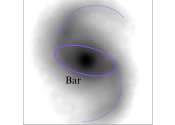Black hole 'traffic jams' discovered in galactic centers by astronomers
An international study, led by researchers from Monash University, has revealed crucial insights into black hole dynamics within massive disks at the centers of galaxies.
Monthly Notices of the Royal Astronomical Society (MNRAS) is one of the world s leading scientific journals in astronomy and astrophysics. It has been in continuous existence since 1827 and publishes peer-reviewed letters and papers reporting original research in relevant fields. Despite the name, the journal is no longer monthly nor does it carry the notices of the Royal Astronomical Society. The first issue of MNRAS was published on 9 February 1827 as Monthly Notices of the Astronomical Society of London and it has been in continuous publication ever since. It took its current name from the second volume, after the Astronomical Society of London became the Royal Astronomical Society (RAS). Until 1960 it carried the monthly notices of the RAS, at which time these were transferred to the newly-established Quarterly Journal of the Royal Astronomical Society (1960–1996) and then to its successor journal Astronomy & Geophysics (since 1997). Until 1965, MNRAS was published in-house by the RAS; since then, it has been published by Blackwell Scientific Publications (later Wiley-Blackwell) on behalf of the RAS. As well, the journal is no longer monthly, with thirty-six issues a year

An international study, led by researchers from Monash University, has revealed crucial insights into black hole dynamics within massive disks at the centers of galaxies.
Astronomy
Apr 24, 2024
0
44

The universe's early galaxies were less chaotic and developed much faster than previously thought, according to new research looking back more than ten billion years in time. An international team of astronomers led by Durham ...
Astronomy
Apr 23, 2024
0
61

The search for extrasolar planets is currently undergoing a seismic shift. With the deployment of the Kepler Space Telescope and the Transiting Exoplanet Survey Satellite (TESS), scientists discovered thousands of exoplanets, ...
Astrobiology
Apr 23, 2024
0
18

A team of international researchers studied galaxy NGC 4383, in the nearby Virgo cluster, revealing a gas outflow so large that it would take 20,000 years for light to travel from one side to the other.
Astronomy
Apr 21, 2024
1
927

From house plants and gardens to fields and forests, green is the color we most associate with surface life on Earth, where conditions favored the evolution of organisms that perform oxygen-producing photosynthesis using ...
Astrobiology
Apr 16, 2024
6
127

Although their primary purpose is to look for exoplanets, observatories like the Kepler Space Telescope and the Transiting Exoplanet Survey Satellite (TESS) have supplied a vast amount of data on stellar flares, detected ...
Astronomy
Apr 15, 2024
0
879

Our solar system and everything within it—including the Earth—will look very different when the sun dies.
Planetary Sciences
Apr 9, 2024
1
306

The birth of stars is a chaotic and dynamic process, especially in the early phase, which is characterized by complex gas structures in the form of spirals and streamers. Such structures are termed "feeding filaments" because ...
Astronomy
Apr 5, 2024
0
31

Galaxies start life with their stars rotating in an orderly pattern but in some the motion of stars is more random. Until now, scientists have been uncertain about what causes this—possibly the surrounding environment or ...
Astronomy
Apr 2, 2024
1
172

There's a population of planets that drifts through space untethered to any stars. They're called rogue planets or free-floating planets (FFPs.) Some FFPs form as loners, never having enjoyed the company of a star. But most ...
Planetary Sciences
Apr 2, 2024
0
76